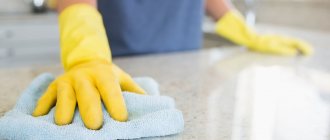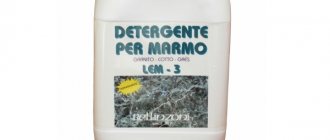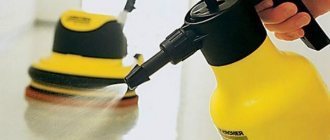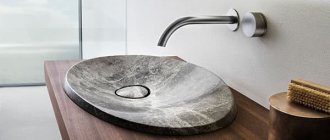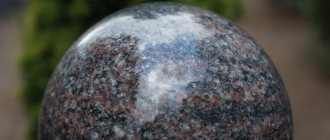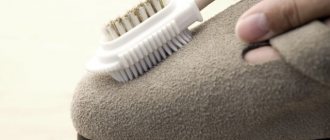Not everyone can afford finishing from natural marble. Stairs, columns, floors, and countertops made of natural marble indicate not only the taste of the owner, but also a certain level of wealth. After all, for a long time only very rich and noble people allowed themselves to decorate palaces and mansions with marble. But in order for this beauty to please the eye for many years, the stone requires care, cleaning with the right products, grinding, and polishing. To do this, you need to know what products can be used and what to polish marble with.
For example, a floor made of marble slabs suffers from women's heels, furniture legs, even sand that gets on the soles of shoes. And if a heavy object falls on the marble, a chip or gouge may form. All these consequences can be removed by sanding, but after it the floor becomes dull and loses its “zest.” You can restore natural beauty with the help of polishing, which not only helps restore color, but makes it more saturated and creates additional effects, for example, “wet stone”. The products applied during the polishing process will make the stone surface resistant to dirt and excess moisture. Proper polishing will eliminate problems with the coating for several years.
Marble grinding and polishing - what is it?
The subtitle contains two important components of stone care. Grinding is a procedure that is used when various defects appear on the surface: chips, scratches, unevenness.
Polishing marble is a simpler, easier and more enjoyable procedure. Helps improve the appearance of the surface, making it mirror-like. This gentle effect affects only the top layer of the material, making it smoother. The process takes place by treating the surface with a special tool.
Why do you need to polish a stone?
To appreciate the unique pattern of the stone, as well as the beautiful mirror tints, it is necessary to polish and polish it. Marble polishing is a rather labor-intensive process and is the final procedure after installing marble floors, stairs and countertops.
By treating the surface of the stone, you can achieve saturation of the natural color of marble.
Many people believe that if they have a marble countertop or floor in their home, then they don’t need to take care of the stone. This is a misconception because marble is a sedimentary rock. The composition of the stone includes minerals, calcite and dolomite.
Therefore, it is fragile and has a “loose” structure. Naturally, over time, multiple damage will begin to appear on the surface. To return natural material to its former beauty, it is necessary to sand it. Using special equipment for polishing marble, you can save even the most unsightly and old surface.
Types of polishing
Marble polishing is divided into two types:
- Primary. It is carried out after laying marble slabs and filling the joints. Here, not only shine is achieved, but also a monolithic surface, which further eliminates the accumulation of dirt in the seams between the slabs. Also at this stage, marble can be given an anti-slip effect, as well as protection from exposure to liquids and various compounds.
- Secondary. Produced as needed during the operation of the coating. The procedure is most relevant for loss of shine.
Polishing equipment
This is a very dense material. Therefore, its processing is carried out using special marble polishing machines. A special tool is also used:
- Diamond flexible wheels. For grinding and polishing hard-to-reach surfaces.
- Milling cutters. For smooth marble surfaces.
- Fiber circles, cups, brushes. Abrasive tools for detailed manual finishing.
Features of choosing a tool
To restore the shine of a smooth, flat surface, you need to use cutters. Such an abrasive tool can have different shapes: in the form of a brush, a cup or a fiber wheel. You can work with it either manually or using grinding equipment.
There is a special machine for polishing marble, but if you need to process a small surface, then purchasing it for one time will be too expensive. In this case, it is better to buy an ordinary grinder, often called a grinder, as well as special diamond discs.
If you don’t know where to start and are afraid that you won’t be able to perform high-quality marble polishing, first assess the depth of the defect and only then choose the right tool. Before starting work, it is worth testing it on a small area of marble, which is located in an inconspicuous, remote place.
Marble care products
But that is not all. You will need marble polishing products - the following range:
- Two-component adhesive. Used to fill scratches and cracks. Matches the color of the marble and even matches its inclusions. Glue is also needed when dirt gets clogged between the slabs. Then the seams expand, and the spaces between them, after cleaning, are filled with this glue or grout.
- Operational polishes. Contains liquid wax or special anti-slip wax. The product protects stone coatings from mechanical damage and helps them remain shiny for a long time. Anti-slip polishes are ideal for marble floors.
- Liquid crystallizer. This universal product, which forms a protective layer, is used after polishing marble. Why do you need a crystallizer? It protects the surface from moisture and mechanical damage. Giving a mirror shine and an anti-slip effect are also its tasks.
- Polishing paste. It can be thick, liquid or creamy. The paste restores an attractive appearance and adds shine. It can be called wear-resistant polishing, which also has a water-repellent effect.
- Marble polishing powder. Characterized by simple use: the product is poured onto the surface, after which the latter is polished to the desired degree. The powder is then quickly washed off by hand with a sponge or machine to prevent staining. For this purpose, it is advisable to treat small surfaces.
Please note that the care for polished and unpolished marble is fundamentally different. In the first case, it is important to give maximum shine, in the second - to emphasize the texture of the stone. Also, paste-like compositions are considered more suitable for machine processing, and liquid ones for manual processing.
Epoxy floors
Although epoxy resin has excellent stability, floors poured with it shrink slightly during the polymerization process. As a result, microwaves and other small defects form on the surface.
If you look at such a floor from above, it will give a distorted reflection, which means that the surface is not ideal. To correct this deficiency, the floors are sanded and polished. True, after this it is necessary to make a coating that prevents slipping. After polishing, epoxy floors become very slippery.
Kitchen aprons, countertops and other decorative elements also require grinding and polishing. This applies not only to new products, but also to those that are already in use. Despite its strength, the resin gradually loses its dazzling shine and requires periodic maintenance.
Sanding epoxy resin is significantly different from the same work on stone. There are some nuances and subtleties here. Professionals are well aware of them, but ordinary people may not even be aware of them.
Polished epoxy resin floor with 3D effect Source sense-life.com
Do-it-yourself polishing
Let us immediately note that polishing marble with your own hands without special equipment is a rather labor-intensive process. The first step is to prepare everything necessary to care for the stone:
- sand;
- paraffin;
- sandpaper with grains of different sizes;
- pumice;
- grinding wheels;
- soft fabric;
- special equipment listed above.
But even with all this at hand, don't expect stunning results from manual processing. Deep damage cannot be dealt with using this method. Hand polishing removes only minor defects and helps restore shine.
The procedure follows this scheme:
- Sanding with sandpaper, pumice, sand. In this way, you need to remove up to 3 mm of the top layer of stone.
- Then it is polished with wax-based products. Can be replaced with paraffin. The products fill microcracks, protecting marble from moisture and dirt. After application, they are rubbed with a soft cloth until a shine appears on the surface.
- The final stage is the use of protective substances. Which ones exactly depends on what you want to see in the end: shine, highlighted structure, wet stone effect, toning, emphasized color.
Frequent damage
What can cause damage to such a durable material as stone? The reasons may be different. For example, if you have a marble floor in the hall or living room, it can quickly deteriorate from frequent rearrangement of furniture, as well as from the fact that dirt and hard grains of sand enter the house from the street along with the soles of shoes.
In addition, marble can also receive more severe damage: potholes and chips that appear as a result of hard, heavy objects falling onto the floor.
Also, the stone itself may lose its shine over the years, become dull, and unsightly cloudy stains may form on it.
In addition to mechanical damage, the marble surface is susceptible to various acids. Therefore, detergents containing acid cannot be used to care for the surface. Marble is also negatively affected by the ingress of various liquids: wine, fruit or berry juice, oils. It can literally burn the top coating of the stone if the stain is not removed in time.
In addition, the wear and tear of a marble surface can directly depend on the frequency and quality of cleaning.
Homemade polishing machine
To process large spaces, you cannot do without professional marble polishing equipment. The cost of such machines varies from several to tens of thousands of rubles. It all depends on the manufacturer, power, and frequency of rotation of the brushes.
Of course, for an apartment with marble floors, it is unprofitable to buy such equipment. Therefore, many people use a regular grinder (angle grinder) and flexible diamond discs for polishing. To successfully remove a layer of marble 2 mm thick, you need to use a device with a power of 700-800 W, designed for a disk diameter of 125 mm.
Now regarding the “turtles”. This is sometimes called flexible diamond discs for grinders. You will need several disks for all the work:
- № 800;
- № 600;
- № 400;
- № 200;
- № 100;
- № 50.
You should start polishing with the coarsest grain - No. 50. As work progresses, change it to No. 100, etc. This sequence will help remove cracks and, when you reach the last disc - No. 800, polish the marble surface to a shine.
There is one more secret. To get a mirror shine, you need to finish the treatment by applying a little silicone to the felt circle, and then walking over the surface again. Dazzling shine is guaranteed. But you must understand that this is a temporary result - it will disappear as soon as the silicone layer is erased.
Now let's look at polishing marble and granite step by step.
Preparatory work
We have reviewed the necessary tools and equipment. Now let's start the process:
- Carefully inspect the surface for defects.
- Fill the cracks with cement-lime and resin fill. An alternative is liquid glass.
- If the marble breaks off somewhere, the pieces should be returned to their place using glue based on synthetic resins.
- Cracks are sealed with special mastics based on perchlorinated varnish or synthetic glue. Additionally, for protection, it is worth using fastenings made of copper staples or stainless steel elements.
Surface grinding
It is important to carry out this procedure immediately before polishing if it is important to you that the marble coating lasts for many years. The work is carried out as follows:
- Prepare the surface thoroughly - clean it with a vacuum cleaner, detergents, organic solvents and plain water with a rag.
- If there are significant uneven spots on the marble, remove them using sanding blocks and wheels. A smooth surface is created with fine-grain sandpaper.
- Grinding itself consists of three stages - rough, normal and finishing. For each, an increasingly smaller number of grinding discs is used.
- As we have already said, you need to remove a layer no thinner than 3 mm.
- If marble is polished on a special machine, then it is best to use a wheel made of cast iron, copper or lead.
- Pumice, fine sand, and fine-grained sandpaper are used as auxiliary materials.
Carrying out polishing on a machine
If polishing is carried out on a machine, then the first step is to remove the plastic case and faceplate from the mechanism. They must be washed and then returned to their place. A polishing wheel is secured and powder is poured onto it. The latter is moistened with water and rubbed over a disk.
Diamond dust, aluminum, zinc, and chromium oxide can be used as powder. It’s a good idea to use cloth, felt or felt. Circles 1-2 cm thick are cut from the materials. They are glued to a cast iron faceplate using sealing wax or shellac.
Sheet rubber is placed between the material and the metal. The cloth circles are wetted before the procedure. During operation, the material is carefully brought and pressed. It is important to move your hand against the rotation of the circle.
Finally, the marble surface is treated with a polymer substance for additional protection. It is considered more desirable than wax because of its durability. It is important to thoroughly clean the surface before applying polymers. After all, even a drop of fat can cause the coating to peel off in the future.
Crystallization
You can choose a chemical type of polishing, the essence of which is to impregnate the marble with crystallizers - weakly acidic substances that “heal” damage and generally strengthen the surface. Another good effect is mirror shine. Processing with crystallizers makes it possible to obtain a very durable coating, not inferior in hardness to marble. In addition, it can be cleaned without fear with traditional detergents.
For a home procedure, you need a rotary mechanism with one disk and special concentrates and powders. The floor must be cleaned before the procedure. A paste is mixed from the compositions and applied to the surface. Processing is carried out until it dries completely.
Thus, for the desired effect, it is worth walking the machine over one area about 15 times. At the end of the procedure, the paste will look more like sour cream. If you are processing a large marble area, it is best to divide it into sectors. In the future, to maintain the gloss of the surface, it is enough to periodically clean it with ordinary detergents.
Polishing marble at home is quite labor-intensive, but possible. The most important thing is to stock up on the necessary ingredients and tools in advance. An ordinary grinder with diamond flexible discs will help you in your work.
Electrical equipment, light, lighting
0 votes
+
Vote for!
—
Vote against!
Coatings made of natural stone, say, marble, have been very popular for centuries. Marble is a fairly expensive stone that requires proper care. From time to time, marble products should be cared for using special synthetic compounds. Also, due to its properties, marble is recommended to be polished. In this article we will look at detailed technology for polishing marble at home and the main ways to care for this natural material.
The need for polishing marble
People began to use marble since ancient times. With the help of this stone, real works of art were created. Marble was used to decorate rooms and decorate various architectural structures. Each of us remembers the old temples and palaces, which were considered a symbol of beauty and harmony. But without appropriate measures, such as marble polishing, it would be quite difficult to appreciate this beauty, because the specific pattern and beautiful mirror tints appear only after polishing the stone.
Polishing marble is the final procedure for processing any products made from this stone - floors, stairs, walls, countertops. Polishing reveals and deepens the natural color of this stone. At the same time, you can apply special impregnations to the marble to enhance the color, create the effect of a wet stone, and have a dirt- and water-repellent effect, which will protect it for a long time. After this procedure, you can forget about problems with marble for the next seven to eight years.
Today everyone believes that marble has increased strength, thanks to which many works of art have been able to survive. However, marble is actually a sedimentary rock, it is very fragile and has a porous structure. How do you like this? Numerous damages gradually appear on it. And here the same marble polishing comes to the rescue, which can save even an old and worn surface.
Marble floors are easily damaged by women's heels, pieces of furniture when rearranged, and even dirt and hard grains of sand carried in from the street on the soles of shoes. Chips and gouges can occur when a heavy object falls onto the surface. Over time, the stone itself loses its unique shine and gloss, becomes dull, and acquires unattractive colored stains.
Marble floors are extremely susceptible to acids, so cleaning products that contain acids can damage the marble polish. Marble is also negatively affected by the ingress of oils and various drinks, for example, juices, wines; if the stains are not removed, they can burn through the polishing of the stone. Therefore, the wear of a marble surface directly depends on the intensity and quality of cleaning of marble surfaces.
Of course, there are a lot of special means to protect marble. For example, marble, which is presented on the construction market today, in order to increase its strength, is often treated with a polymer resin, which fills the smallest cracks that are in the marble. But, as practice shows, marble still needs high-quality grinding and polishing.
In addition, when laying marble slabs, a seamless type of installation is often used, which can create unevenness, so the leveling process is very important. The final product should have a monolithic appearance without the slightest seam. Do-it-yourself leveling grinding and polishing of marble during the initial laying of tiles is carried out in order to eliminate differences in height, level out unevenness between individual elements and achieve a perfectly smooth and mirror-like surface.
Marble polishing technology
If you do not want to resort to rough types of marble polishing, it is necessary to maintain constant cleanliness and prevent dirt from penetrating the surface, since polishing marble yourself is quite a difficult job.
Preparatory work
For the polishing procedure you will need the following materials and equipment: sandpaper of different sizes, soft cloth, pumice stone, grinding equipment or marble polishing machine, crystallizer, paraffin, drill with special attachments, abrasive tools, two-component glue, sand and stone care products containing wax.
As a rule, so-called abrasive and diamond wheels are used for polishing marble. Using a diamond flexible wheel, you can grind and polish hard-to-reach surfaces. For smooth and flat surfaces, it is more rational to use cutters. Abrasive tools can be made in the form of brushes, fiber wheels and cups.
Moreover, with these tools you can process marble both manually and using equipment. There are special machines, but they are very expensive and there is no point in buying them for processing a small marble surface. It is better to use a standard grinder, called a grinder, and flexible diamond discs.
But if you have some concerns about the quality of the work, or you don’t know which tool is best, try to assess the depth of defects and damage on the surface. It is also recommended to choose tools taking into account the result you want to get in the end. In addition, before starting work, you can always test the operation of marble polishing equipment in an inconspicuous place.
First, you should carefully inspect the surface so that you can remove minor defects. If cracks appear on the material, it is necessary to apply resin or cement-lime filling. You can also seal them with liquid glass. If any parts of the stone break off, they should be glued together using synthetic resin glue.
To do this, you need to select an adhesive that will match the marble in color and transparency, since the composition should be invisible on natural inclusions. Cracks can be repaired using special mastics, which are made on the basis of the above adhesives or perchlorovinyl varnish. When gluing and filling cracks, it is advisable to use additional fastening with pyrons or staples made of copper or stainless steel.
Marble polishing
Grinding is one of the important stages of marble coating processing. If you want to use the product for a long time, you should not neglect this procedure, which significantly increases the service life of the marble. Before starting sanding, it is necessary to clean with a vacuum cleaner, organic solvents or use detergents. Rinse the surface well with a cloth and water.
Immediately before sanding, the surface is moistened with fine sandpaper. If there are uneven or noticeable differences in the surface, you should first use coarse abrasives, such as grinding wheels and bars. If you want your marble to shine and look smooth, you should use multiple numbers of abrasives, as shown in the marble polishing video.
The grinding process can be divided into three stages: coarse grinding, normal grinding and finishing - each time a less coarse number should be used. To give the stone a monolithic appearance, it is necessary to remove a fairly large layer of material. The recommended thickness is three millimeters. It is better to polish the floor with special machines.
For small items, they can be sanded with fine-grain sandpaper. For grinding, you can also use pumice or fine sand as auxiliary materials. If you plan to grind marble on a machine, it is recommended to use a wheel made of lead, copper or cast iron.
Marble polishing
Before you start polishing your marble, you need to thoroughly clean the surface. But polishing is also carried out using fine, erased iron oxide and sulfur. This powder must be applied and the surface rubbed until shiny with a piece of leather. After this, the stone should be sprinkled with paraffin and gently rubbed with a dry soft canvas. This way you can give it a good shine and protect it from harmful environmental influences.
If you are going to polish a marble product using a machine, you need to remove the faceplate and plastic body, and then wash them thoroughly. The clean parts can then be reinstalled and polishing can begin. To do this, according to marble polishing technology, you should fix the polishing wheel and pour a pinch of powder on it, which must be moistened with water and rubbed in a circle.
It is recommended to use zinc, diamond dust, aluminum or chromium oxide as polishing powder. Next, you can turn on the motor and slowly polish the material. You can also use felt, felt or cloth for polishing. Circles with a thickness of ten to twenty millimeters should be made from these materials. The circles must be glued to the cast iron faceplate using shellac or sealing wax.
A sheet of rubber must be placed between the polishing material and the metal. Before polishing, you should slightly moisten the circles made of felt, felt or cloth. When operating the machine, the material should be carefully approached and pressed. In this case, the hand should move against the rotation of the circle. For additional protection, the marble surface should be polished with a polymer coating until the desired result is achieved.
These marble polishes are more durable than wax polishes, but it is necessary to thoroughly clean the surface before application, since even a drop of grease can lead to peeling of the coating in the future. If you treat the surface in this way, you will provide the material with additional protection.
In order to check the quality of polishing, wipe the polished surface with a clean cloth and stand near a switched on electric lamp. On the surface of the marble, try to find the reflection of a filament of a burning lamp. If it is there, then you managed to polish the material well.
Crystallization process
You can also choose a chemical technology for polishing a marble surface, in which the surface is impregnated with crystallizers. These weakly acidic substances heal scratches and strengthen the surface. After crystallization, the polishing quality improves significantly. This is expressed in the mirror shine of the marble floor.
As a result of this treatment, a very durable coating is formed, which is in no way inferior in hardness to the original marble. This type of treatment is recommended for use in areas with high traffic (if it is a floor). By the way, you can use classic detergents to clean such a floor, but you shouldn’t walk around too much.
For crystallization at home, you will need a special rotary machine with one disk, as well as powders and concentrates. Before crystallization, the floor must be cleaned. After this, you should make a concentrate mixture and apply this marble polishing paste to the desired area. Crystallization of marble is carried out before the mixture dries.
In order for the stone to acquire its original gloss, it is necessary to walk over it with a machine about fifteen times. When crystallization is complete, the mixture will resemble sour cream and the machine will begin to move faster. If you want to treat a large area of marble flooring, you should divide it into sections and treat them one by one. To maintain the gloss after crystallization, it is necessary to periodically clean the surface using detergent.
Recommendations for caring for marble
For marble, only special gentle detergents or soapy water should be used. Classic cleaning products have an acidic and alkaline base, so they can ruin the surface. It is recommended to use a detergent with a pH level of no more than 7. Before application, it is advisable to test the product in an inconspicuous place. It is worth noting that suede prevents streaks, so it is better to clean the surface with this material.
There is one good product for cleaning marble. It is necessary to prepare a thick solution of gum arabic and cover the surface with it using a brush. Once the gum arabic is completely dry, you can easily remove it from the surface of the marble. All foreign substances that contaminate the marble should go along with it. It is better to cover the marble floor at the entrance door with a carpet. This way, you will protect the surface from constant pressure and destruction by shoes.
If you find a stain on a marble surface, the main thing is to react quickly and not leave it for tomorrow. Immediately pat it dry with a towel, then rinse gently with water and dry. At the same time, try not to rub the surface too much. You can put a piece of wet clay in place of the greasy stain. When it dries completely, it will absorb the fat.
To remove stains of organic and inorganic origin, oil, grease, and cosmetics from marble, you should use an absorbent paste. To remove biological stains, it is better to use a mold remover. To remove rust, special products are used to neutralize oxides.
If you need to remove scale, salt, mineral and calcium stains from marble, you should use concentrated acid and alkaline products. In some cases, traces of corrosion may remain, so the marble will have to be repolished using high-quality equipment. In this case, the price of marble polishing will be slightly higher.
If you want marble to retain its shine for a long time, you need to periodically impregnate it with special compounds containing wax or silicone. These compounds allow the material to breathe, protect it and provide shine. If you spill tea or coffee on the material, it may stain it because these liquids contain acids. Therefore, water- and oil-repellent impregnations are often used to protect marble. In order not to clean the marble in the future, it is better to immediately impregnate it with protective agents that will fill the pores and prevent the penetration of unnecessary substances.
Marble is a naturally soft sedimentary material; over time it becomes dull and loses its luster. Small cracks may also appear on it. For these reasons, the material must be polished and sanded periodically. And in order to preserve its original appearance and shine, it is also necessary to carefully care for it and wash the surface using special products.

